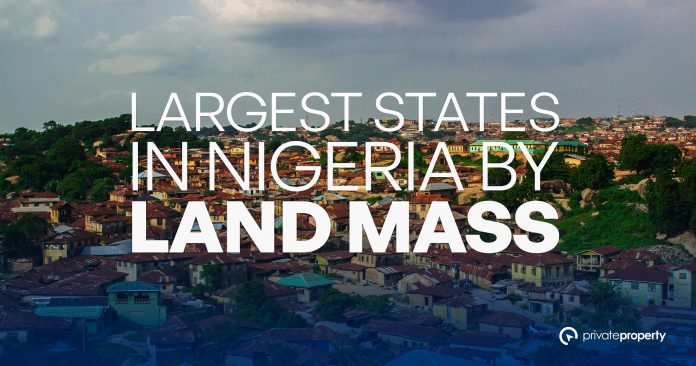Welcome to a fascinating exploration of Nigeria’s geographical diversity! Nigeria, a country known for its rich cultural heritage and vibrant population, is also home to a diverse landscape, with vast stretches of land that vary greatly in size. In this post, we will delve into the largest states in Nigeria by landmass, shedding light on the expansive regions that contribute to the country’s immense diversity and natural beauty.
From the lush forests of the south to the arid expanses of the north, join us on a journey to discover the Nigerian states that command the most extensive territories, each with its unique character and significance.
But before we dive in,
What is Landmass?
Landmass refers to the total area or expanse of land within a particular geographical region or boundary. It is a term commonly used to describe the land area of a country, state, continent, or any other defined area of land on Earth’s surface. Landmass is typically measured in square kilometers or square miles and includes all the land, whether it’s inhabited, or covered by forests, deserts, mountains, or any other type of terrain.
Understanding the landmass of a region is essential for various purposes, such as geographical studies, urban planning, resource management, and demography. It provides valuable information about the size and extent of a land area, which can be crucial for assessing its geological, ecological, and socio-economic characteristics.
1. Niger State – 76,363 Square kilometers
Central Nigeria is home to Niger State. With a population of 3,950,249 and a land area of 76,363 square kilometres, it is the largest state in Nigeria. Other significant cities include Bida Kontagora and Suleja, as well as the state capital of Minna. It was established in 1976, under General Murtala Mohammed’s rule. Of the several indigenous tribes in Niger State, the most are the Nupe, Gbagyi, Kamuku, Kambari, Dukawa, and Koro. The River Niger inspired the state’s name. The Kainji Dam and the Shiroro Dam, two of Nigeria’s principal hydroelectric power plants, are situated in Niger State, along with Gurara Local Government and the well-known Gurara Falls.
2. Borno State – 70,898 Square kilometers
Nigeria’s northeastern Borno State is located. It was created in 1976 as a result of the division of the North-Eastern State, and Maiduguri serves as its capital. The Kanuri are in charge of the state. The southern region of the state is also home to several minor ethnic groups such the Lamang, Babur, and Marghi. There are 27 Local Government Areas, a total area of 70,898 square kilometres, and 4,151,193 people living there.
Borno State, Nigeria is regarded as one of the largest states since a stretch of Lake Chad partially encircles the territory. The state’s vegetation is thought to be of the Sudan savanna variety. There are many forests in the state, including the well-known Sambisa forest in Nigeria.
3. Taraba State – 54,473 Square kilometers
The Taraba River, which flows through the state’s southern region and gave its name to Taraba State. Jalingo is Taraba’s capital city. After being separated from the previous Gongola State in 1991, Taraba State has a square area of 54,473 km2. 2,300,736 people call it home as of this moment.
The Taraba State is regarded as a beautiful state since it is home to well-known tourist destinations, such as the well-known Mambila Plateau, a stunning setting covered with green grass.
The gongola state, which is no longer extant, served as the foundation for Taraba State. Along with our well-known tribes from the north of Nigeria, the Fulani, Jukun, and Tiv dominate the state.
4. Kaduna State – 46,053 Square kilometers
In the northern region of Nigeria, there is a state called Kaduna State. According to the 2006 census, Kaduna, which was founded in 1967 and also includes the contemporary Kastina state, was listed as the 18th largest city in the nation. Since the name of the state was reportedly picked by the colonial master at the time, Kaduna is derived from the term “Kada,” which means crocodile.
Due to its location on the highest part of the Nigerian plain, Kaduna State is thought to have a huge land area. The Sudan Savanna, which contains trees and shrubs, is what gives Kaduna State in Nigeria its distinctive vegetation. The state is bordered by hills and the famous Kaduna river, which also serves as a waterway.
5. Bauchi State – 49,119 Square kilometers
Northern Nigeria is home to Bauchi. There are currently 4,676,465 people living in the state, which was created in 1976 when the previous North-Eastern State was divided. It once covered the territory that is now part of Gombe State, a separate state since 1996. Bauchi State covers an area of 45,837 square kilometres. There are 20 local governments there.
Along with Jos, the state is bordered by other notable northern states including Kano State and Jigawa State. Bauchi State, established in 1976, is largely dominated by Hausa groups such the Tangale, Jarawa, and Gerawa.
In Bauchi State, 85% of religious activities are related to Islam, with the remaining 15% related to other religions.
6. Yobe State – 45,502 Square kilometers
Nigeria’s northern region includes Yobe state. The current Borno State was split into the Yobe State in August 1991, and because of the state’s extensive agricultural activity, it is regarded as one of the nation’s food baskets. Yobe state, whose geography is made up of plains and other terrains that are drained by the Yobe river, is regarded as the sixth-largest state in Nigeria.
The state’s vegetation, which also includes acacia trees and thorns scrub that are dispersed throughout the state, is recognised to be composed of Sudan savanna vegetation.
7. Zamfara State – 39,762 Square kilometers
One of the northern states in Nigeria, Zamfara is located in the country’s northern area.
The inhabitants of Zamfara state, which was established in 1991, are known to have agitated for independence and a distinct state up until 1996, when the then-military administration complied by carving out the current Zamfara State from Sokoto state.
Zamfara State is noted for having a thriving economy thanks to its agricultural and camel-rearing industries.
8. Adamawa State – 36,917 Square kilometers
One of the largest of the 36 states, Adamawa state is a northern state that is located in the northern region of Nigeria.
The Bwatiye, Bali, and Gudu ethnic groups are among those that have controlled the Adamawa State since it was founded in August 1991.
Prior to the creation of the modern-day Adamawa state, the Fulani are said to have taken certain residents and ruled the area for a number of years before being overthrown and replaced by the Germans.
The World War encouraged the allied forces to occupy the state after the defeat; the state was later liberated when Nigeria attained independence in 1960.
9. Kwara State – 36,825 Square kilometers
Our list of the major states in Nigeria appears to include Kwara State as the lone western state.
Popular Yoruba state Kwara State is bordered by two Northern and two Western States and is located in the country’s western region.
Kwara State, established in May 1967, is known to have been home to and inhabited for many years by a number of different ethnic groups, with the Yorubas being the most numerous.
10. Kebbi State – 36,800 Square kilometers
Kebbi State is located in the country’s northern region. The Fulani and Zama people are among the several ethnic groups that are reported to dominate and live in the current Kebbi state, which was established in August 1991.
The Fulani conducted many raids on the Kebbi people in an effort to seize control of their Kingdom, but the Kebbi people fought the invasions for a considerable amount of time before the colonial overlords arrived and took control.
At around 36,800 KM2, Kebbi State is now ranked as the tenth-largest state in Africa. Their landmass is made up of short-grass savanna, which the Niger River drains.
In conclusion, our journey through Nigeria’s largest states by landmass has revealed the vast and diverse landscapes that make up this remarkable nation.
As the largest state in Nigeria, Niger State proudly carries its name, derived from the mighty River Niger, which not only lends its name but also powers two of the nation’s critical hydroelectric power stations.
Other states with large land masses contribute to the rich real estate we have In the country.
Which is the smallest state in Nigeria by land mass?
Lagos State claims this title with a land area of approximately 3,345 square kilometers. However, don’t let its size deceive you, as Lagos stands as the most densely populated state across the nation.
Remarkably, Lagos also reigns supreme in the economic sphere, earning its place as a pivotal player in Nigeria’s economic landscape.
Is Abuja one of The List of top 10 largest states?
No, Abuja is not among the top 10 largest states in Nigeria. In fact, it is one of the smallest states in terms of landmass. Abuja, as the capital city of Nigeria, is known for its administrative and political significance rather than its expansive geographical size. It is characterized by its relatively limited land area, with fewer rivers and forests compared to the larger states in the country. Therefore, Abuja does not make it to the list of the top 10 largest states in Nigeria.









